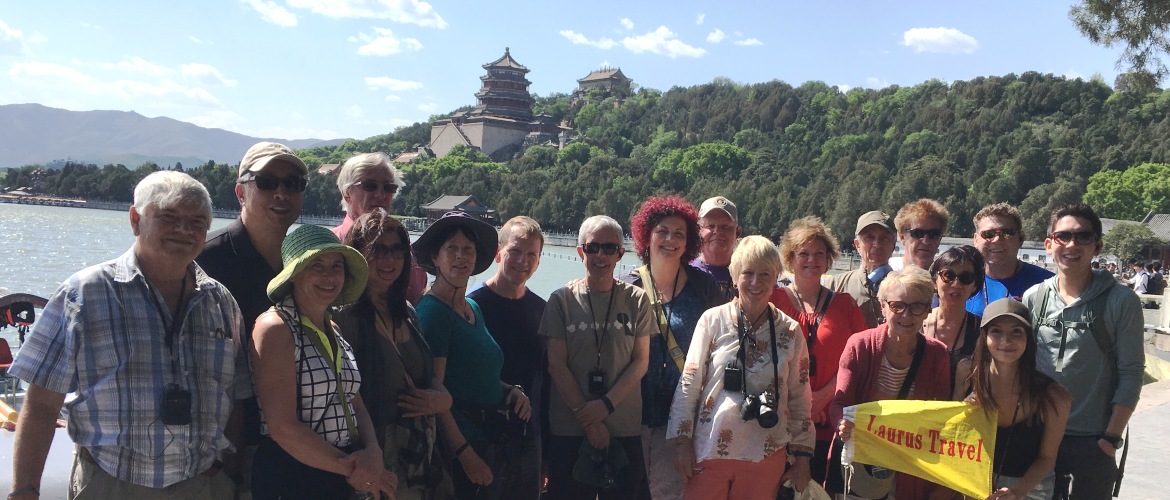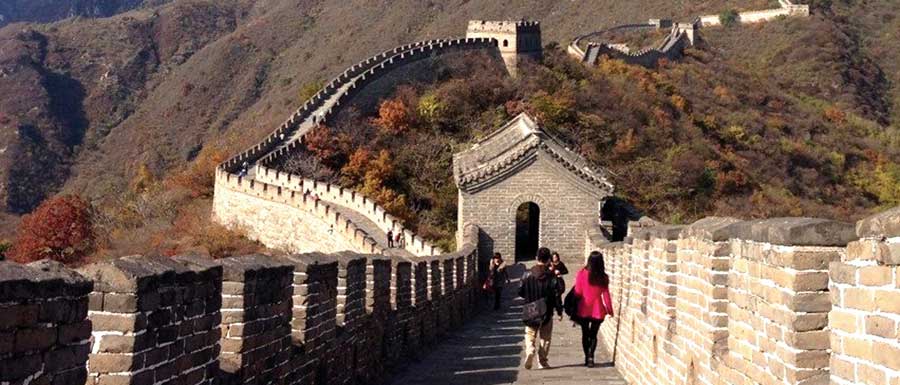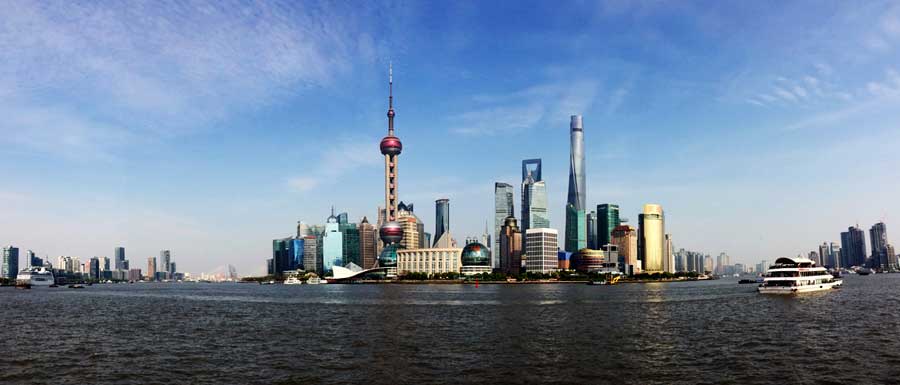
Beijing – Xi’an – Shanghai
Combining China’s top three tourist cities, this popular China luxury tour offers is an excellent introduction to the Middle Kingdom. Tour highlights include the Great Wall at Mutianyu, the Forbidden City and the world-renowned Terracotta Army Museum.
Important Features
- Highest quality in this price category backed by a stellar record of 26 years!
- Outstanding guides handpicked by company owners.
- Small group size – average 15, maximum 20.
- Inter-city travel by high-speed train.
- No annoying forced shopping of any kind.
- Quality meals at non-tourist restaurants.
- Unlimited supply of bottled water during group activities.
- Complimentary Wi-Fi in all hotels.
- Great Wall visit at Mutianyu including cable car rides.
OPTIONS AVAILABLE
Meal Code: B = breakfast / L = lunch / D = dinner
Day 1/Thu: Departing for Beijing
The trip starts with your transpacific flight departing from a city of your choice. You’ll lose a day upon crossing the International Date Line.
Day 2/Fri: Arrival in Beijing
Meet the driver on arrival for transfer to the hotel. You’ll have the remainder of the day at leisure. The guide will get in touch with you tonight.
Day 3/Sat: Beijing (B/L/D)
The capital of China, Beijing is a world-class cultural and educational centre with a population of 21.9 million (2020), ranking it China’s second largest city behind Shanghai. Beijing is renowned for its opulent palaces, temples, and huge stone walls and gates – treasures that make it the most popular tourist city in China by the number of visitors it receives every year.
We begin today with a visit to the Forbidden City. Officially known as the Palace Museum, the Forbidden City was the place where the emperors of the Ming (1368-1644) and Qing (1644-1912) dynasties lived and carried out their administration. Construction of the Forbidden City took 14 years (1406-1420) to complete. The complex consists of 980 buildings and covers 72 hectares or 180 acres. It exemplifies traditional Chinese palatial architecture and has influenced cultural and architectural developments in East Asia and elsewhere. Though the Qing Dynasty was overthrown in 1912, the royal family was allowed to continue to live in the Forbidden City till 1924, when the last emperor, Pu Yi, was driven out of the imperial palace. One year later the Forbidden City was turned into a museum. Declared a World Heritage Site by UNESCO in 1987, this is the largest collection of preserved ancient wooden structures in the world.
Next comes Tian’anmen Square. Located in the heart of Beijing, the square measures 880 metres from north to south and 500 meters from east to west. Said to be the largest public plaza in the world, Tian’anmen Square has the capacity to hold one million people. The imposing Tian’anmen Tower sits at the north end of the square while the Monument to the People’s Heroes dominates the centre. The square is flanked by The Great Hall of the People (west) and the National Museum (east). Chairman Mao’s Mausoleum and Qianmen (Front Gate) are located in the south of the square. One of the top 16 tourist attractions in Beijing, Tian’anmen Square is also the witness of the Chinese people’s great struggles for democracy and personal freedom since 1919.
Afternoon sightseeing takes place at the Temple of Heaven, another UNESCO World Heritage Site. Situated in southeastern Beijing, the Temple of Heaven is China’s largest extant sacrificial temple where, during the Ming and Qing Dynasties, the emperors conducted the elaborate and most exalted sacrifices addressed to “the Supreme Ruler of the Universe.” Construction of the temple started in 1406, during the reign of the Ming Emperor Yongle, and took 14 years to complete. The temple was expanded under the Qing emperors Qianlong (1736-1796) and Jiaqing (1796-1820). Occupying 2.73 square kilometres (roughly 1,700 by 1,600 metres), the area of the Temple of Heaven is more than twice that of the Forbidden City.
The famous Hongqiao Pearl Market, the largest pearl market in the world, is right across the street from the Temple of Heaven. Recommended by numerous guidebooks for freshwater pearls, Hongqiao teems with domestic and international shoppers. If you are interested, please ask the guide to drop you off there. However, you’ll need to get back to the hotel by taxi, which costs the equivalent of 10 US dollars or less.
Today we enjoy a delicious dinner at a popular Peking Roast Duck restaurant. Peking Roast Duck is a famous Beijing dish prized for the thin and crispy skin with authentic versions serving mostly the skin and little meat, sliced in front of the diners. The meat is wrapped in a thin layer of pancake (Chinese tortilla) together with shredded scallion, cucumber, and a sweet and salty sauce made of wheat flour. Condiments may also include pickled garlic and white sugar.
Day 4/Sun: Beijing (B/L)
After an early breakfast we embark on a full-day excursion to the legendary Great Wall at Mutianyu, 75 km northeast of the city.
Zigzagging over 6,000 kilometres from east to west along the undulating mountains, the Great Wall was built to hold off tribal invaders from the north. As history shows, the Wall failed the Chinese rulers miserably, especially in the case of Kublai Khan who and his men swept across China from the Mongolian steppe, thus the beginning of the Yuan Dynasty (1279-1368).
Construction of the earliest sections of the Wall started in the 7th century BCE. A major renovation started with the founding of the Ming Dynasty in 1368 and took 200 years to complete. The wall we see today in Beijing is almost exactly the result of this effort.
Day 5/Mon: Beijing – Xi’an (B/L/D)
We begin our sightseeing today with a visit to a traditional hutong neighbourhood. Hutong refers to an ancient alleyway with siheyuan or ”4-sided courtyard house” on both sides. The name hutong dates back to the Yuan Dynasty (1279 – 1368 CE). According to some experts, the word originated from the Mongolian language, in which it is pronounced as hottog and means “well.” In ancient times, people tended to gather and live around wells. So the original meaning of hutong should be “a place where people live around”.
Next on our schedule is the Summer Palace, a well preserved UNESCO World Cultural Heritage Site. The imperial resort was first named Garden of Clear Ripples, which was burnt down by the allied forces of Great Britain and France in 1860 at the end of the Second Opium War (referred to as Arrow War by the British). Reconstruction started 25 years later and was completed in 1895 when the name was changed to Yi He Yuan (Garden of Good Health and Harmony). The design gives prominence to Longevity Hill, as well as Kunming Lake south of the hill. The sprawling complex covers an area of 290 hectares and the buildings inside consist of over 3,000 bays.
We travel to Xian by high-speed train (#G87, 14:00/18:23). The 4-hour-23-minute rail journey through fertile farmland dotted with villages provides the visitor with an excellent way to enjoy the beautiful countryside. The track you travel on between Beijing and Zhengzhou is part of the new 2,298 km high-speed railway linking Beijing and subtropical Guangzhou and is also the longest high-speed rail line in the world. In the past 20 years China has been on a building spree expanding the country’s rail network and upgrading existing railways. Its new high-speed rail service rivals France’s TGV and Japan’s shinkansen in terms of safety, speed, comfort and punctuality.
Day 6/Tue: Xi’an (B/L)
With a history going back over 3,000 years, Xi’an served as China’s capital of several ruling dynasties including the Han (206 BCE – 220 CE) and the Tang (618 – 907). It is home to the famous Terracotta Army and the eastern terminus of the ancient Silk Road – a network of trade routes connecting China proper with regions as far as the Mediterranean beginning in the Second Century BCE.
We spend the morning visiting the Terracotta Army Museum located 30 km east of the city. Designed to follow the first emperor of the Qin Dynasty (221-206 BCE) into eternity, the Terracotta Army represents one of the greatest archeological discoveries of the 20th century.
After lunch we return to the city for a stroll on the ancient city wall. Declared a national treasure by the State Council in 1961, the wall (first built in 1370) encircles an area of 14 square kilometres. It runs 13.7 kilometres long and measures 12 metres in height with a thickness at the base between 15 and 18 metres.
Day 7/Wed: Xi’an (B/L)
Morning sightseeing begins at Shaanxi Provincial Museum. The modern, well-organized museum was completed in 1992 and traces the history of Xian from prehistory to Qing dynasty (1644-1912). The extensive galleries and exhibitions offer the visitor an excellent introduction to the area that greatly improves understanding of the numerous historical sites in and around the city.
We then visit the grand mosque in the old town centre and the adjacent Muslim bazaar. The mosque was established in the 8th Century but the majority of the complex was constructed in the Ming Dynasty (1368-1644). It was further expanded in the Qing Dynasty (1644-1912). Unlike mosques elsewhere, this one is completely Chinese in architectural style. It has neither domes nor traditional minarets.
Day 8/Thu: Xi’an – Shanghai (B)
Ride the high-speed train (#G362, 08:49/14:45, 1,509 km) to Shanghai after breakfast and transfer to the hotel upon arrival.
With a population around 25 million, Shanghai is China’s largest city. It delights visitors from around the world with its futuristic skyline and historical landmarks. As China’s leading gateway to the world, Shanghai plays a prominent global role as a hub of commerce, finance, cultural exchange, fashion, technology and transport.
Day 9/Fri: Shanghai (B)
Free day to explore on your own. We recommend Shanghai Museum and the Urban Planning Exhibition Center nearby. Shanghai Museum, a great place to explore on your own, is frequently cited by visitors as one of the best of its kind in China with a huge collection of precious national treasures.
Optional Suzhou Day Tour
After a leisurely breakfast we ride the high-speed train (30-40 minutes) to Suzhou, an ancient city most famous for its gardens, canals and silk industry. In late 13th Century a Venetian named Marco Polo visited Suzhou and he was very impressed by what he saw. He vividly described the prosperous silk making trade and dubbed Suzhou “Venice of the East” due to the small waterways crisscrossing the city.
Our full-day schedule takes in historic Tiger Hill, Humble Administrator’s Garden, Suzhou Museum (designed by I.M. Pei), North Pagoda and a short canal cruise. We return to Shanghai by high-speed train (30-40 minutes) in early evening.
The all-inclusive price with hot lunch starts from US$250 per person subject to a minimum of 2 participants.
Day 10/Sat: Shanghai (B/L/D)
We begin our day with a visit to Jade Buddha Temple located in an old neighbourhood. Later on we tour the famous waterfront promenade known as the Bund, which is followed by the Yu Garden in the old town centre. We wrap up the day with a drive through the glitzy financial district of Lujiazui on the opposite side of the Bund across Huangpu River.
Day 11/Sun: Returning Home (B)
The incredible China tour ends this morning. Transfer to the airport any time for return flight. Guests flying back to North America will regain a day upon crossing the International Date Line, thus arriving home the same day as departing from Shanghai.
| City | Nights | Hotel | Category |
| Beijing | 3 | New Otani Chang Fu Gong | Luxury / 5 stars |
| Xi’an | 3 | Sheraton North City | Luxury / 5 stars |
| Shanghai | 3 | Amara Signature Shanghai | Luxury / 5 stars |
Dates & Prices
discount available
Prices are per person based on double occupancy.
| Depart (Thu) |
Return (Sun) |
Land Only* CA$/US$ |
Single Supplement CA$/US$ |
| 2025 | |||
| 13-Mar | 23-Mar | $2995/$2140 | $950/$680 |
| 20-Mar | 30-Mar | $2995/$2140 | $950/$680 |
| 27-Mar | 06-Apr | $2995/$2140 | $980/$700 |
| 03-Apr | 13-Apr | $2995/$2140 | $1015/$725 |
| 10-Apr | 20-Apr | $2995/$2140 | $1015/$725 |
| 17-Apr | 27-Apr | $2995/$2140 | $1050/$750 |
| 08-May | 18-May | $2995/$2140 | $1015/$725 |
| 15-May | 25-May | $3075/$2195 | $1050/$750 |
| 22-May | 01-Jun | $3075/$2195 | $1015/$725 |
| 29-May | 08-Jun | $2995/$2140 | $980/$700 |
| 05-Jun | 15-Jun | $2995/$2140 | $980/$700 |
| 12-Jun | 22-Jun | $2995/$2140 | $980/$700 |
| 19-Jun | 29-Jun | $2995/$2140 | $980/$700 |
| 26-Jun | 06-Jul | $2995/$2140 | $980/$700 |
| Please contact us for July departures | |||
| 07-Aug | 17-Aug | $2995/$2140 | $980/$700 |
| 14-Aug | 24-Aug | $2995/$2140 | $980/$700 |
| 21-Aug | 31-Aug | $2995/$2140 | $980/$700 |
| 28-Aug | 07-Sep | $2995/$2140 | $1050/$750 |
| 04-Sep | 14-Sep | $3075/$2195 | $1015/$725 |
| 11-Sep | 21-Sep | $3075/$2195 | $1085/$775 |
| 18-Sep | 28-Sep | $3075/$2195 | $1085/$775 |
| 09-Oct | 19-Oct | $3075/$2195 | $1085/$775 |
| 16-Oct | 26-Oct | $3075/$2195 | $1085/$775 |
| 23-Oct | 02-Nov | $3075/$2195 | $1085/$775 |
| 30-Oct | 09-Nov | $3075/$2195 | $1085/$775 |
| 06-Nov | 16-Nov | $3075/$2195 | $1015/$725 |
| 13-Nov | 23-Nov | $2995/$2140 | $980/$700 |
| 20-Nov | 30-Nov | $2995/$2140 | $980/$700 |
* Land Only price does NOT include international airfare. Please contact us for a fare quote.
|
What the tour price includes:
|
What the tour price excludes:
See Terms & Conditions for more information. |



